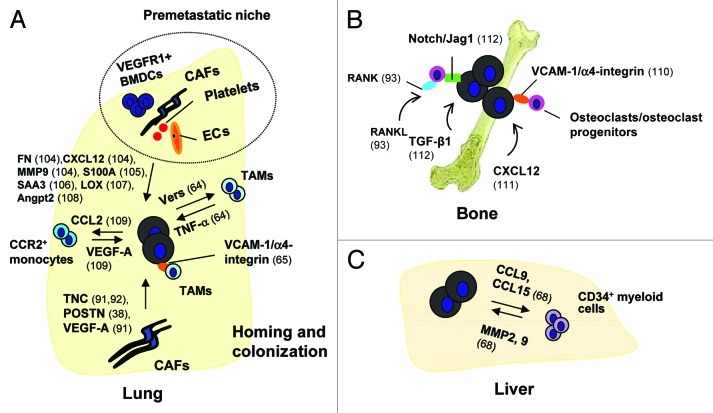Figure 2. The role of tumor-associated stroma priming for infiltration and colonization by CTCs. (A) Contribution of tumor-associated stromal cells to development of pulmonary metastasis. The formation of a pre-metastatic niche, facilitating homing and colonization of CTCs specifically in the lung has been shown to be aided by signaling molecules secreted by cells from primary tumors [e.g., vascular endothelial growth factor A (VEGF-A)].47 It is believed that VEGFR1+ bone marrow-derived cells (BMDCs), endothelial cells, CAFs and platelets, expressed by the ECM, and signaling molecules, such as fibronectin (FN),104 CXCL12,104 MMP9,104 S100A,105 serum amyloid A (SAA) 3,106 lysyl oxidase (LOX)107 and angiopoietin 2 (Angpt2),108 are all involved in mediating the formation of a pre-metastatic niche. To further promote metastatic colonization, monocytes, TAMs and CAFs, regulated by cancer cells, continue to contribute to forming a specific metastatic niche. It has been shown that breast cancer cells forming pulmonary metastases secrete the CCL2 chemokine109 which mediates infiltration of lung tissue by CCR2 receptor-expressing monocytes. These cells, in turn, produce VEGF-A which stimulates extravasation and seeding of the lung by additional cancer cells. Pulmonary metastatic breast cancer cells secrete the ECM proteoglycan versican which allows recruitment and activation of TAMs via Toll-like receptor 2 (TLR2).64 Activated TAMs in turn produce TNF-α which stimulates pulmonary metastatic colonization by breast cancer cells. In addition, interaction of breast cancer cells expressing vascular cell adhesion molecule-1 (VCAM-1) with the α4-integrin receptor expressed by myeloid cells activates PI3K/Akt signaling in tumor cells and increases their survival.65 ECM proteins produced by CAFs, such as tenascin-C (TNC)91,92 and periostin (POSTN),38 are also implicated in metastatic niche formation in the lung and promotion of pulmonary colonization by breast cancer cells. Not only CAFs, but also S100A4+ fibroblasts, a cell population within CAFs, secrete VEGF-A which induces angiogenesis and thereby promotes metastatic spread and colonization by breast cancer cells.91 (B) The role of tumor-associated stroma in facilitating bone metastasis. Interaction between VCAM-1 expressed on breast carcinoma cells and α4-integrins expressed by osteoclast progenitors elevates local osteoclast activity, thereby aiding conversion of indolent micrometastasis to macrometastasis.110 Bone marrow mesenchymal cells promote survival of breast cancer cells via secretion of the CXCL12/SDF-1 chemokine and CXCL12-dependent activation of c-Src signaling.111 TGF-β released from its reservoir during ECM degradation accompanying bone destruction, induces Jag1 expression on breast carcinoma cells.112 Jag1-activated Notch signaling promotes carcinoma cell proliferation, but also activates osteoclast differentiation allowing further destruction of bone.112 RANKL produced by the bone microenvironment activates RANK receptors expressed on osteoclast progenitors and osteoclasts, leading to bone destruction and metastatic cancer cell colonization.93 (C) Involvement of tumor-associated stroma in liver metastasis. Colon cancer cells secrete CCL9 and CCL15 which recruit bone marrow-derived CCR1+CD34+ myeloid cells into the liver.68 These myeloid cells in turn produce MMP2 and 9 which both facilitate liver colonization by metastatic colon cancer cells.68

An official website of the United States government
Here's how you know
Official websites use .gov
A
.gov website belongs to an official
government organization in the United States.
Secure .gov websites use HTTPS
A lock (
) or https:// means you've safely
connected to the .gov website. Share sensitive
information only on official, secure websites.
